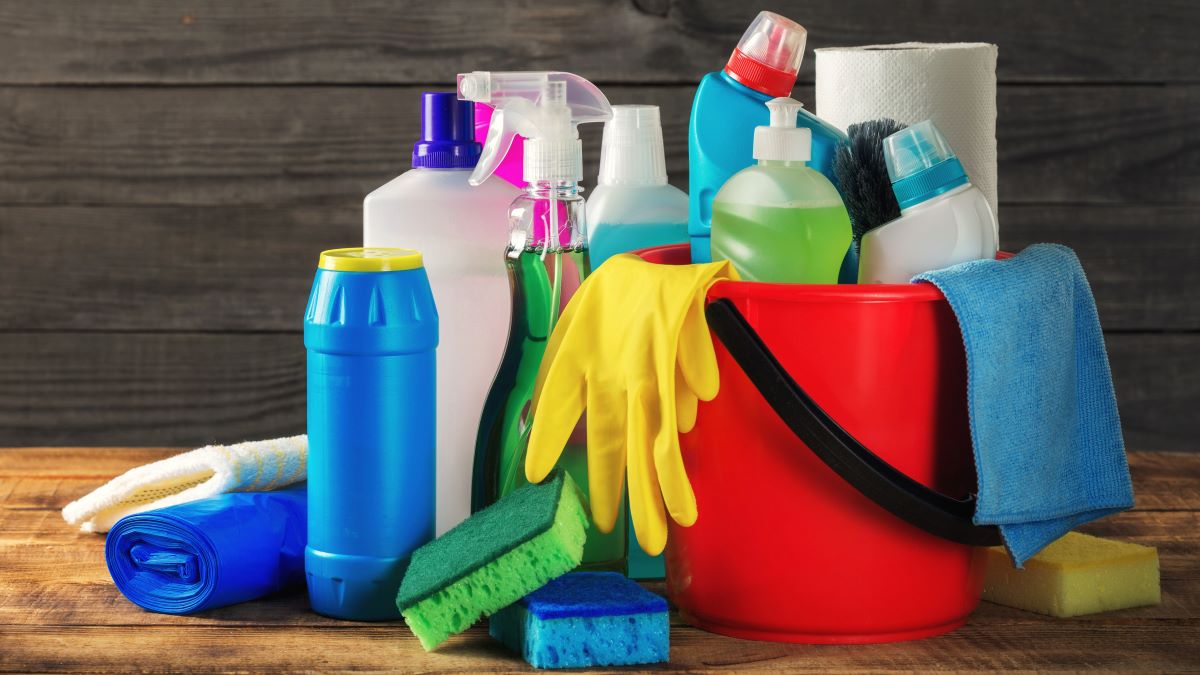Sometimes cleaning products must be cleaned out, too. What’s the best way to clean up a cleaning mess?
Because the natural household cleaners market growing from $6.97 billion in 2024 to a projected $13.28 billion by 2030, consumer awareness about the harmful effects of conventional chemical-based cleaning products has never been higher. A 2023 Environmental Working Group study analyzing 30 everyday cleaning products found that they emit 530 unique volatile organic compounds (VOCs), of which 193 are hazardous—potentially causing respiratory damage, increased cancer risk, and developmental impacts.
Americans generate approximately 1.6 million tons of household hazardous waste annually, with the average home accumulating as much as 100 pounds of HHW in garages, attics, and storage closets. The good news? You have more disposal options than ever before.
Use It Up or Give It Away
The best and easiest option for dealing with unused cleaning products is simply to use them up. Sometimes this isn’t possible, though—perhaps you’re moving a long distance and can’t take the cleaners with you. In such cases, your best bet is to give unused cleaning products away to a local charity, church, or homeless shelter. You can make a big difference in the lives of people in need by donating your usable products like dishwasher detergent, surface cleaners, and bleach.
Also, let your friends and neighbors know what you want to give away. Chances are, someone will be happy to take the products off your hands. Make sure that all items are in their original containers so that they are handled correctly.
If you can’t find an organization that will take your products and no one you know needs them, try a community reuse site like Freecycle.org or Nextdoor.com.
Read the Label for Proper Disposal
Still can’t find anyone who wants your household cleaners? Typically, cleaning products can be disposed of just like other regular household waste. But before you dispose of them, be sure to read the label to see if there are any specific disposal instructions.
If the manufacturer doesn’t provide ingredient information, the American Cleaning Institute suggests considering how you typically use the product to help you make the best disposal choice. For example, if you have extra laundry detergent or liquid disinfectant, it is generally safe to pour it down the drain with running water.
Because these products are water-soluble and usually mixed with water when used for cleaning anyway, your municipality will treat these cleaners the same way they would if you used them for cleaning. But don’t pour too much cleaning material down the drain at once if the cleaner isn’t in liquid form. Powder can clog your drain, so pour it slowly with the water running.
One commonly asked question about disposing of cleaning products down the drain is whether they will harm a septic tank. In almost all cases, the answer is “no.” Septic systems commonly used in homes can process water-soluble cleaning products.
If you have solid household cleaners or wipes, you can safely dispose of them in your trash. For other types of cleaners, like furniture polish and oven cleaners, check with your local waste disposal facility for any special instructions. Some products may be considered hazardous household waste and require special handling.
New Brand-Sponsored Recycling Programs
Several major brands now offer take-back and recycling programs specifically for cleaning product packaging:
TerraCycle PartnershipsMethod has partnered with TerraCycle to accept pumps, triggers, refill pouches, and almost any cleaner product packaging, regardless of brand, through their Cleaner Packaging Brigade program. Seventh Generation participates in TerraCycle’s Loop program, which delivers cleaning products in durable, reusable packaging that customers return for cleaning and reuse.
Clorox Refill Programs Clorox launched a refillable wipes system in 2022 designed to reduce plastic waste by 80%, allowing consumers to reuse containers while purchasing only refill packs. More than 75% of CloroxPro product packaging is now recyclable, with many containers made from 25% post-consumer recycled plastic.
Procter & Gamble InitiativesP&G: P&G launched plant-based household wipes in 2023, emphasizing biodegradable ingredients and reduced plastic packaging, aligning with consumer demand for greener alternatives.
How to Participate Most brand-sponsored programs are free to join. Visit the company’s website or sign up through TerraCycle.com (search for the brand name to find programs), then collect your empty cleaning product containers (any brand is typically accepted), and ship them using prepaid labels. Many programs offer rewards.
Always Recycle (and Precycle) Packaging
Once you’ve disposed of your extra cleaning products, it’s time to recycle those containers. Most household cleaning products come in containers that should be easy to recycle in your curbside bin. Because local rules vary widely, please get in touch with your local recycling program if you have any doubts about how to recycle these items:
- Common cleaning product container plastics are PET and HDPE, labeled as plastic #1 and #2, respectively, and are among the easiest to recycle. Rinse the container thoroughly before placing it in the bin.
- Aerosol cans, often used to hold spray disinfectants, glass cleaners, and furniture cleaners, are accepted by a growing number of local recycling programs.
- Cardboard boxes, like those used to hold powdered detergent for the dishwasher or for clothing, can be recycled with other paper products.
Please make sure all product is rinsed or shaken free of the container before recycling.
For Hard-to-Recycle Items, TerraCycle’s Cleaning Supplies and Accessories Zero Waste Box accepts packaging that can’t go in curbside bins, including spray triggers, pumps, and small containers—across all brands. The collected packaging is cleaned, melted into hard plastic, and remolded into new recycled products.
You can also further reduce waste by precycling—purchasing products that are in containers that are easy to recycle. Choose products with recycled packaging and consider cleaners that use less packaging, such as concentrated detergents. By selecting easy-to-recycle or concentrated products when you make your purchases, you help reduce waste at the source—and that’s the best option of all.
Additional Resources
- Find a household hazardous waste facility: Search Earth911’s database for your local solid waste and recycling programs
- Brand recycling programs: Visit TerraCycle.com to find participating brands and sign up for free mail-in programs
- Beauty and personal care recycling: Ulta Beauty, Sephora, and Credo Beauty also partner with Pact Collective for in-store drop-off of hard-to-recycle packaging
- Make your own cleaners: Many cleaning jobs can be done using simple alternatives like baking soda and water for mild abrasive cleaning, or vinegar and water for windows. Visit the EPA’s Safer Choice program for more environmentally responsible product options.
Editor’s Note: Originally published on October 3, 2022, this article was substantially updated in November 2025.
Source link
Earth911 earth911.com



